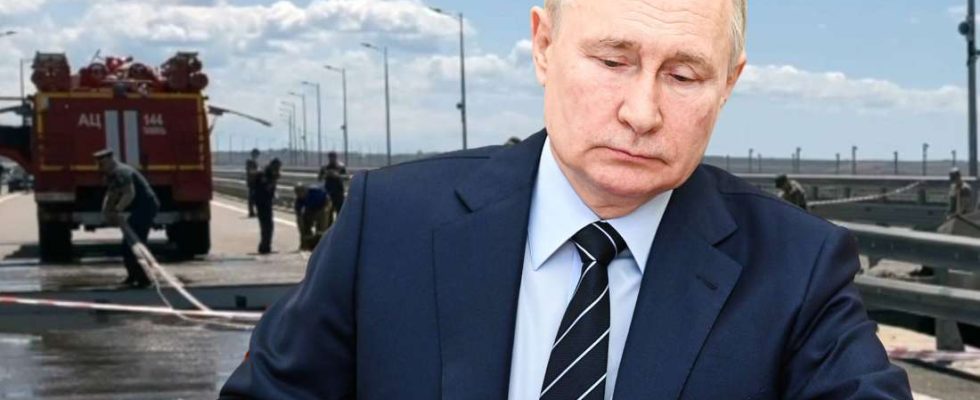Resistance to annexation in the Ukraine war: the Crimean Tatars declare guerrilla warfare to Putin. Are they also behind the explosion on the bridge?
Update from July 19, 12:50 p.m.: The attacks on the Crimean Peninsula, annexed by Russia, continue. After a fire at a military site, 2,000 people have to be evacuated from the surrounding area. The residents of four towns are affected, said the local governor Sergei Akjonov via telegram. Because of the fire, the Tawrida highway was closed. The Ukrainian news agency RBC-Ukraine reports that there were explosions on the military premises on Wednesday night.
A report after Ukraine spoke of a “successful operation” after the fire has since been denied. Ukrainian authorities have clarified that the comments were distributed from an unofficial Telegram account and are false.
Crimean bridge explosion: Crimean Tatars swear revenge on Putin
KIEV – Checkpoints blown up, barracks and fuel depots on fire, and repeated explosions: Ukraine is resolutely pursuing plans to recapture Russian-occupied Crimea. For this, Ukraine relies military pinpricks in their offensive. On Monday (July 17) the bridge connecting the Ukrainian region with mainland Russia became the target. Pro-Ukrainian partisan movements play a significant role in this – particularly the Crimean Tatars, who have vowed to take revenge on Putin for years of harassment.
According to Mustafa Dzemilev, a spokesman for the Crimean Tatar movement, hundreds of Tatar men are ready to liberate occupied Crimea from Russia in the Ukraine war. In an interview with the British Guardians he referred to numerous acts of sabotage by the partisan group called Atesh (“Fire”), which according to previous knowledge consists of Ukrainians, Crimean Tatars and renegade Russians.
After Crimean Bridge destroyed: Crimean Tatars support Ukraine offensive
The Atesh partisans are actively supporting the Ukraine offensive and are targeting Russian military installations behind the front line. It is unclear whether they are also responsible for the renewed attack on the Crimean Bridge. On Monday there was an explosion while crossing to the Russian mainland, which showed a destroyed roadway in photos and videos. Apparently, the bridge was attacked with a surface drone.
Moscow called the attack according to the Russian news agency mug as an “act of terrorism” and held Ukrainian secret services responsible for it. The Ukrainian authorities did not confirm their involvement for the time being, but only commented on the situation: “The bridge has gone to sleep again. And one … two!” This may have referred to a similar attack last fall, to which Kiev claimed responsibility, in which a roadway was also destroyed. The damage was then repaired by Russia.
Annexation of Crimea: Ukraine does not give up on counter-offensive
Ukraine has been defending itself against Russia’s war of aggression for almost 17 months and has announced that it will free all occupied parts of the country from annexation, including Crimea, in a counter-offensive. However, the peninsula is relatively far behind the direct front line, which means that the Ukrainian armed forces cannot yet attack the area with heavy tanks. The range of many missile and artillery systems is also insufficient for direct attacks.
Against this background, targeted acts of sabotage behind the front line offer the only possibility to attack Russian troops in Crimea. According to the British media report, the Atesh resistance group has already successfully destroyed Russian checkpoints, damaged fuel depots, killed officers and obtained intelligence for the Ukrainian secret service.
Atesh Movement: Partisans oppose Putin
Who exactly is behind the partisan warfare of the Crimean Tatars is largely unknown. “Atesh operates deep underground,” confirmed Dzhemilev. It seems that the guerrilla movement was only founded in September last year and is estimated to have grown to up to 1000 fighters. This could pose a serious threat to Russian President Vladimir Putin.
Crimean Tatars and their 1944 deportation
The Turkish-speaking Crimean Tatars are considered the indigenous people of Crimea. Their settlement began in the 13th century. But its history with Russia is one of conflict. After the first Russian annexation in 1783, their expulsion began. In 1944, many Crimean Tatars were deported to Uzbekistan by Stalin.
In particular, many Crimean Tatars are suffering from the Russian occupation of the peninsula. Although they currently make up just 13 percent of Crimea’s population, according to Dzhemilev, around 85 percent of political arrests and illegal searches are aimed at them. Crimean Tatar activists are therefore disproportionately often the victims of kidnapping. 49 supporters are currently missing and political leaders and dozens of activists have been arrested.
Ukraine war: Crimean Tatars provide “useful network”
Given these circumstances, it is not surprising that support for the partisan movements is increasing. In any case, the Ukrainian army appreciates this support. “Crimean Tatars serve in the armed forces of Ukraine and play an active role in partisan operations in Crimea,” Presidential Advisor Mykhailo Podolyak told dem Guardians adding: “There is quite a wide network in Crimea at the moment, which is very useful. There are certain incidents that prove that.” However, it remained unclear whether he also meant the attacks on the Crimean Bridge.
In any case, Russia still has to be prepared for attacks behind the defense lines. Putin friend Sergey Mardan bluntly warned on state television of increasing attacks “deep inside Russia”. He was referring to partisan attacks on the Kursk and Belgorod railway lines. “The strategy that the enemy is implementing is aimed at capturing Kursk in order to transfer the war to the territory of Russia,” the propagandist said. The recent explosion at the Crimean Bridge, which happened just hours after he commented, shows at least some of his assessment is not entirely wrong. (jkf)
This article was created with the help of machines and carefully checked by editor Jens Kiffmeier before publication.

